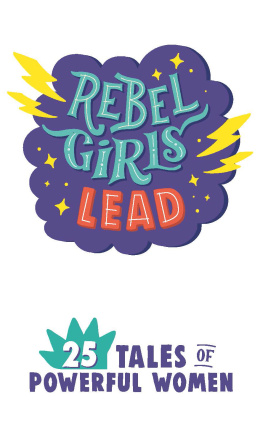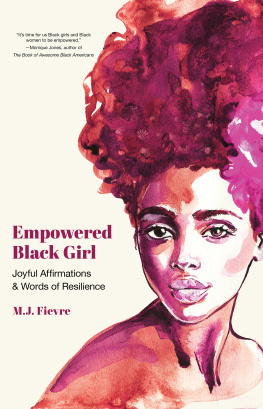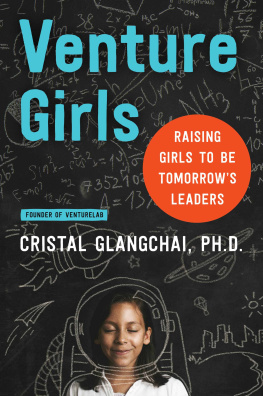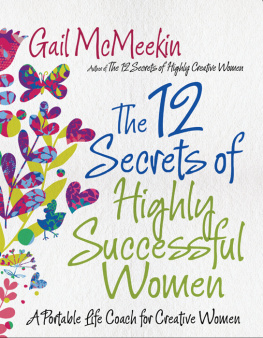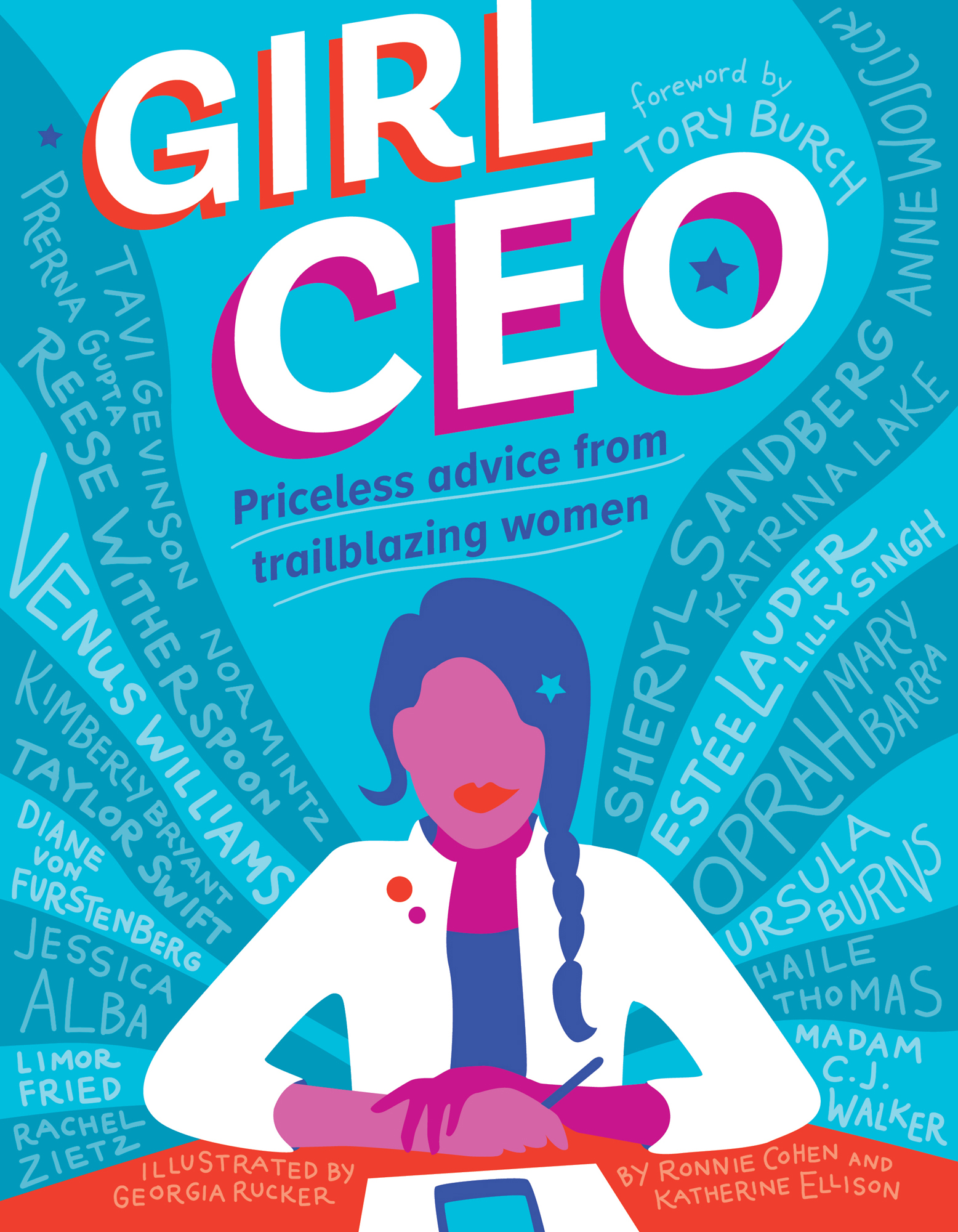CONTENTS
Guide
Girl CEO
Priceless advice from trailblazing women
Foreword by Tory Burch
Illustrated by Georgia Rucker
by Ronnie Cohen and Katherine Ellison
FOREWORD
I f you are curious about how other women have succeeded in business, you are probably thinking about how you will make your mark in the world. This could be the first sign of your ambition, and I hope you will embrace it.
When I first thought about launching a fashion company, there were many obstacles. I had to raise money. I had to convince people that it made sense to launch with a retail store and an e-commerce site. People told me that no one would buy online. But I believed in what I was doing. I knew what was missing from my closet, and I thought other women might be missing similar things. So I kept making phone calls and sharing my ideas. I assembled a team of amazing people who could help me turn my concept into a collection, and we all worked incredibly hard. We knew we were onto something when we almost sold through our inventory on the first day. Ambition and perseverance turned out to be good things.
There is more to my story. I started my company because I wanted to start a foundation for women. The Tory Burch Foundation empowers women entrepreneurs by providing affordable loans, business education, mentorship, and a fellowship program. As you think about your future, I hope you will also think about ways that you can give back from the outset.
There are many different measures of success, but to achieve any of them, it is important to believe in yourself and your ideas. Dream big and embrace your ambition!
TORY BURCH
Founder of Tory Burch Foundation
Chairman, CEO, and designer of Tory Burch
INTRODUCTION
W hat do you want to be when you grow up? As the 40 women in this book demonstrate, your choices are limitless. Maybe you want to program robots to help kids with disabilities. Or create your own TV network. Or lead a major manufacturing company. Or start a doggy daycare franchise. Or be the first woman tofill in the blank.
The world needs more women with big dreams. So let your imagination fly!
Haile Thomas and Rachel Zietz, two young women profiled in the book, had a clear idea about what they wanted to do when they were just 12 years old. Haile channeled her concern over her fathers diabetes diagnosis into a nonprofit organization. Rachel turned her love of lacrosse into a business. Other women in the book discovered their passion when they were well into their adult years. Theres no rush to decide as long as you enjoy the adventure of discovery. Then, whatever you choose, we hope youll wake up every morning, or at least most mornings, looking forward to going to work.
We also hope the women described in these pages inspire you on your journey, wherever it leads. Many of the women are entrepreneurs, which means they came up with an original idea for a company and then created it. Some of them run their own businesses as chief executive officers, or CEOs. Still others have disrupted their industries by changing the rules to their advantage.
We chose a diverse group of women, born as early as 1839 and as recently as 2004. They come from varied racial, ethnic, and economic backgrounds. Oprah Winfreys family was so poor when she was growing up in Mississippi that she wore dresses sewn from potato sacks. Joy Mangano was struggling to pay her electric bill and support her three young children when she invented her Miracle Mop. At the other extreme, Diane von Furstenberg benefited from the financial support and social ties of her husband, a wealthy prince, when she introduced her clothing line.
Most of the women earned college degrees. Four went on to earn advanced degrees in business administration. A few attended college on scholarships and financial aid. Not all completed college. LSTN founder Bridget Hilton went straight from high school to work in the music industry.
Some came to this country as immigrants or were born to immigrants. Because Hooked founder Prerna Gupta and YouTube star Lilly Singh, both children of immigrants, experienced the world as outsiders, they developed the kind of dogged determination entrepreneurs need to succeed.
Many of the women blazed new trails. Mary Barra worked her way up from GMs factory floor to become the first woman CEO of a major automaker. Ursula Burns was the first African-American woman to lead a Fortune 500 company. Muriel Siebert was the first woman to own a seat on the New York Stock Exchange. Katharine Graham was the first woman publisher of a major American newspaper. Judy Faulkner started a medical software company in 1979, when very few women worked in technology.
Backed by their economic power, several of these entrepreneurs have revolutionized aspects of their industries. Pop star Taylor Swift has found new ways for musicians to control how their concert tickets are sold. Sheryl Sandberg, Facebooks chief operating officer, has inspired women to lean in and power their way to the top of corporations. By teaching African-American girls to program computers, Kimberly Bryant, founder of Black Girls Code, intends to transform the face of the technology industry.
Each womans journey offers a different lesson. But we were struck by how much these leaders had in common.
Taking risksan important part of an entrepreneurs jobwas a recurring theme. Rosanna Pansino invested her lifes savings to make her wildly popular Nerdy Nummies YouTube videos. Francesca Kennedy quit her high-paying job at a financial-services firm to sell sandals and provide jobs and clean drinking water in Guatemala.
Of course, sometimes taking risks can be dangerous. Thats just the point. Yet several women insisted that they learned more from failing than from succeeding. They stressed how important it was to pick themselves up after making a mistake. Ive learned that failure is just a step towards greatness, said Heidi Ganahl, founder of Camp Bow Wow. Dont fear it, embrace it.
When faced with challenges, many women turned to their families. Noa Mintzs father helped her launch a website and register her babysitter service as a business. Alice Waters parents mortgaged their house so she could start her influential restaurant. Some women gave special credit to their mothers for encouraging them. The fighter mentality that Anne Wojcicki learned from her mother helped her endure a year when she almost lost control of her company, 23andMe.
Several women incorporated philanthropy into their companies after realizing customers were demanding products that pair charity with merchandise. Francesca Kennedy, Bridget Hilton, and Mikaila Ulmer knit social missions into the core of their businesses.
We wrote Girl CEO against the backdrop of a growing, social-media- driven movement to empower women. The #MeToo and #TimesUp campaigns have exposed and challenged male harassment of women in the workplace. Regardless of how womens opportunities change in the future, one thing will remain the same. It will continue to be up to every one of us to put in the effort and take the risks required to find and keep work thats fulfillingand pays the bills. The days of women being kept out of corporate boardrooms and top leadership roles are overand good riddance, right? As these 40 women show, if you find your passion and work hard, the skys the limit. Write your own story.




